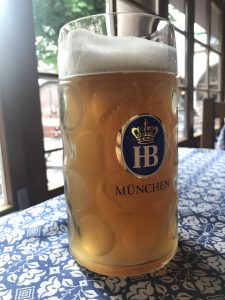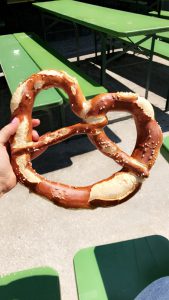Beer, brezen, and bar maidens: The trinity of Munich life. From the beer drinking gardens to Oktoberfest costumes, American perceptions of Germany may represent reality.
Why It’s Newsworthy: When cities modernize to meet the future, there’s a risk of losing the past. Munich seems to meet both challenges.
#1: To Beer or Not To Beer
Germany is home to more than 1,500 breweries, the most of any European country according to The Brewers of Europe 2016 statistical study. Currently ranking as Europe’s third largest consumer of beer, the beverage plays an important part of daily life.
From lunch meetings to train rides to night time events, drinking in public is legal and commonplace in Munich. If your trip to Munich is beer-motivated, you’ll have no trouble finding a place to indulge.
Take a bike ride to Chinesischer Turm, a famous beer garden in the English Gardens. On my visit to the garden, our bike guide sat down with a hefty liter and pointed to a table nearby.
“Right over there, I got hired drinking one of these,” he said proudly holding his beer.
The Hofbrauhaus dubs itself “the world’s most famous tavern.” A popular tourist attraction, you can enjoy a beer here in a range of sizes.
Stoneware beer steins are a popular souvenir to take home because of their intricate designs. If you make the rounds of popular tourist shops you’ll find them priced around 100 euros. These steins are reusable and can withstand the wear and tear of stein clinking.
Go up in size, and the ‘Mass’ size contains one liter of beer and can be found in the hands of thousands of Oktoberfest celebrators. These massive mugs are also a common vessel at beer gardens.
Peter Gerard, server of five years at the Hofbrauhaus, says that from Friday to Sunday, they serve “at least 10,000 pint beers.”

Germans consumed 101.2 liters of beer per capita in 2017, according to the German Wine Institute Report. On the streets, in train stations, you’ll likely find a place to buy a beer. But if beer isn’t your drink of choice, you still have options—Germany specializes in the production of other beverages as well. ‘Radlers’ are a less intimidating version of beer. All you have to do is mix any dark, medium, or light beer with lemonade and you have a refreshing, and not as filling, drink.
Nonalcoholic wheat beers can also be ordered at beer gardens and restaurants.
Alternatives
Bavaria’s 13 wine production regions are growing destinations for visitors and wine connoisseurs.
Based on the German Wine Institute Report statistics, German wine exports are growing both in amount and price. Wine consumption in 2017 was 20.9 liters per capita, making it the second favorite alcohol type consumed.
#2: The Massive Brezen (or Pretzel)
The massive pretzels have been around long before tourists posted them on Instagram. The tale of the salt-crusted treat has multiple origin stories, but the German Food Organizationconcludes the common history that the Bavarian pretzel has its roots in the Catholic church.
Before they were introduced to the Western world, pretzels were considered a holy food with healing powers. Standing the test of time, there’s no denying pretzels are a favorite choice of locals and tourists today, too. In the Marienplatz train station alone, I counted four bakeries selling them within walking distance of one another, all carrying multiple types of the pretzel.

According to baker Lillian Adler at the Rischart café in the Marienplatz, “We make the pretzels at least five times a day to keep them fresh.” She said that the brezen are usually the first off the shelves.
Outside of bakeries, you can find this snack in beer gardens as well.
Dafina Mekker, a Brotfrauen or “bread lady” at the Hofbrauhaus, carries around a massive basket filled to the brim with pretzels every shift. She said the number of brezen sold “depends on the shift and time of day.”
“On a day shift I sell at least 100, but at night definitely more than 300,” Mekker said. “Pretzels were made for beer drinkers,” she laughs.
Beyond the shocking size appeal, the versatility of brezen plays a part in its popularity.
Mekker thinks beer mustard is best to pair with the pretzel since it “balances out the salt”, but pretzel pairing with red radish, cheeses, and meats are also common in her opinion.
The WeiBwurst, a Munich specialty, combines pretzels with white sausages for a morning snack. If salt’s not your thing, some pretzels are sugar coated instead and are dipped in chocolate.
Low priced, customizable and accessible, brezens have been a German crowd favorite since the 12thcentury.
#3: Tracht
When you picture a beer maiden costume, what you’re likely thinking of is actually called ‘tracht,’ the traditional fashion of Bavaria. Worn by Bavarian men and women, tracht for men consists of lederhosen, button down shirts and knee socks while women wear a dress called a dirndl, apron and blouse.

Tracht was adapted in the Alpine regions of Bavaria and Austria centuries ago to distinguish social class and occupations in the areas.
Although tracht isn’t worn on a daily basis as it once was, you can still find men wearing lederhosen around the Marienplatz from time to time. Genuine tracht is rarely worn in its original form except for on special occasions such as weddings.
In present day, you can find tracht in a variety of stores ranging in quality and price throughout the Munich area.
On the less expensive end, ‘Almenrausch’, a store outside the Marienplatz, offers the fashion for 49.95 euro. If your trip to Munich is Oktoberfest specific, other affordable stores like ‘Bavarian Outfitters’ and ‘Dirndl, Lederhosen, Souvenirs’ could be the best bet for one-time wear to stay within this 50 euro range.

If you don’t want to indulge in the full dirndl, designer brands have developed every day wearable alternatives to what you might imagine.
A step up in price, styles found at Ludwig Beck range in the hundreds of euros and offer more traditional pieces along with modern ones. Lodenfrey also sells traditional and more modern tracht in a variety of price ranges.
If you’re searching for high-quality tracht that’s slightly less ‘beer maiden’ typical, stores like Lodenfrey and Beck could be the place for you.
Timeless Tradition
A trip to Munich promises beautiful architecture, history lessons, and a modern look into the past. If you want to indulge in the more ancient tokens of Bavarian past, you’ll have no trouble finding them throughout the city center today.
Lorna Ramage is a junior studying journalism at the Grady School of Journalism.








